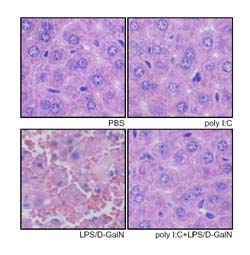

Pretreatment with poly I:C-attenuated LPS-induced acute liver injury in C57BL/6 mice.
Recent studies of a team led by Prof TIAN Zhigang from the University of Science and Technology of China (USTC), a CAS affiliate, have shed new light on the treatment and prevention of hepatitis with their discovery that the pretreatment with polyinosinic-polycytidylic acid (poly I:C), an artificial mimic of viral RNA, could significantly block the invasion of liver by pathogens.
Innate immunity is the first line of defense against infection and transformed cells (such as tumor). Its losses or damages could lead to a variety of severe diseases in human body. Lipopolysaccharide (LPS), a major bacterial component, can trigger an outbreak of induced fulminant hepatitis via its interference on the Kupffer cells, a kind of innate immune cells in the liver. Recently, a family of mammalian receptors has been identified that resemble a Drosophila receptor called Toll. Toll receptors in the fruit fly and similar molecules in plants trigger the release of antimicrobial peptides in response to infection, possibly representing a very ancient form of innate immunity. In mammals, at least ten Toll-like receptors have been identified. The best characterized is Toll-Like Receptor 4 (TLR-4) on macrophages.
The work by CAS researchers shows that pretreatment with poly I:C can significantly decrease the mortality and liver injury caused by the injection of LPS. Further research reveals that, poly I:C can act on the toll-like receptor 3 (TLR3) by lowering the expression of TLR4 in the same cell so that LPS would lose its targets in the action.
This work was published in the Dec. 22, 2005 issue of
the Proceedings of National Academy of Sciences (PNAS). It first depicts an interactive dialogue between the TLR3 and TLR4, which will be interesting to both hepatologists and immunologists, notes a paper reviewer of
PNAS.
There have been many studies devoted themselves to the regulation of TLRs, mostly concentrated on the TLR analogues or some protein molecules as downstream products to the TLRs. The research by Prof. Tian and colleagues is the first revelation of the regulatory mechanism between different TLRs, which plays a guiding role for deeper exploration into the natural immune system and deepen our understanding of the formative mechanism for making clear the eruptive outbreak of hepatitis. So, new thinking approaches are to be suggested for prevention and control of the scourge.






